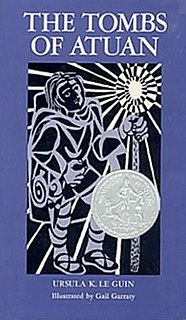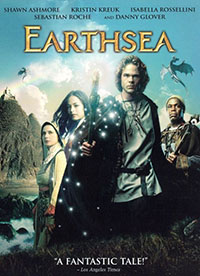
A Wizard of Earthsea is a fantasy novel written by American author Ursula K. Le Guin and first published by the small press Parnassus in 1968. It is regarded as a classic of children's literature, and of fantasy, within which it was widely influential. The story is set in the fictional archipelago of Earthsea and centers around a young mage named Ged, born in a village on the island of Gont. He displays great power while still a boy and joins the school of wizardry, where his prickly nature drives him into conflict with one of his fellows. During a magical duel, Ged's spell goes awry and releases a shadow creature that attacks him. The novel follows his journey as he seeks to be free of the creature.

Ursula Kroeber Le Guin was an American author best known for her works of speculative fiction, including science fiction works set in her Hainish universe, and the Earthsea fantasy series. She was first published in 1959, and her literary career spanned nearly sixty years, yielding more than twenty novels and over a hundred short stories, in addition to poetry, literary criticism, translations, and children's books. Frequently described as an author of science fiction, Le Guin has also been called a "major voice in American Letters." Le Guin herself said she would prefer to be known as an "American novelist".

The Tombs of Atuan is a fantasy novel by the American author Ursula K. Le Guin, first published in the Winter 1970 issue of Worlds of Fantasy, and published as a book by Atheneum Books in 1971. It is the second book in the Earthsea series after A Wizard of Earthsea (1969). The Tombs of Atuan was a Newbery Honor Book in 1972.

The Earthsea Cycle, also known simply as Earthsea, is a series of high fantasy books written by the American writer Ursula K. Le Guin. Beginning with A Wizard of Earthsea (1968), The Tombs of Atuan, (1970) and The Farthest Shore (1972), the series was later supplemented by Tehanu (1990), and Tales from Earthsea and The Other Wind. In 2018, all the novels and short stories were published as The Books of Earthsea: The Complete Illustrated Edition, with illustrations by Charles Vess.

The Farthest Shore is a fantasy novel by the American author Ursula K. Le Guin, first published by Atheneum in 1972. It is the third book in the series commonly called the Earthsea Cycle. As the next Earthsea novel, Tehanu, would not be released until 1990, The Farthest Shore is sometimes referred to as the final book in the so-called Earthsea trilogy, beginning with A Wizard of Earthsea. The events of The Farthest Shore take place several decades after The Tombs of Atuan and continue the story of the wizard Ged.

The Other Wind is a fantasy novel by the American author Ursula K. Le Guin, published by Harcourt in 2001. It is the fifth and final novel set in the fictional archipelago Earthsea. It won the annual World Fantasy Award for Best Novel and was runner up for the Locus Award, Best Fantasy Novel, among other nominations.

Tehanu: The Last Book of Earthsea is a fantasy novel by the American author Ursula K. Le Guin, published by Atheneum in 1990. It is the fourth novel set in the fictional archipelago Earthsea, following almost twenty years after the Earthsea trilogy (1968–1972), and not the last, despite its subtitle. It won the annual Nebula Award for Best Novel and the Locus Award for Best Fantasy Novel.

Tales from Earthsea is a collection of fantasy stories and essays by American author Ursula K. Le Guin, published by Harcourt in 2001. It accompanies five novels set in the fictional archipelago Earthsea.
"The Rule of Names" is a short story by American writer Ursula K. Le Guin, first published in the April 1964 issue of Fantastic, and reprinted in collections such as The Wind's Twelve Quarters. This story and "The Word of Unbinding" convey Le Guin's initial concepts for the Earthsea realm, most importantly its places and physical manifestation, but not most of the characters appearing in the novels, other than the dragon Yevaud. Both stories help explain the underpinnings of the Earthsea realm, in particular the importance of true names to magic.
"The Word of Unbinding" is a short story by American writer Ursula K. Le Guin, first published in the January 1964 issue of Fantastic, and reprinted in collections such as The Wind's Twelve Quarters. In this story, the Earthsea realm, which was later made famous by A Wizard of Earthsea, was first introduced. Along with the story "The Rule of Names", this story conveys Le Guin's initial concepts for the Earthsea realm, most importantly its places and physical manifestation, but not the characters appearing in the novels.

Charles Vess is an American fantasy artist and comics artist who has specialized in the illustration of myths and fairy tales. His influences include British "Golden Age" book illustrator Arthur Rackham, Czech Art Nouveau painter Alphonse Mucha, and comic-strip artist Hal Foster, among others. Vess has won several awards for his illustrations. Vess' studio, Green Man Press, is located in Abingdon, VA.
The Kargs are a fictional people in Ursula K. Le Guin's Earthsea canon.

Legend of Earthsea is a two-part television fantasy miniseries produced for the Sci-Fi Channel. It is an adaptation of the Earthsea novels by Ursula K. Le Guin. The teleplay was written by Gavin Scott, and the series was directed by Robert Lieberman. It was an American-Canadian co-production, filmed on-location in Vancouver, British Columbia.

Tales from Earthsea is a 2006 Japanese anime epic fantasy film directed by Gorō Miyazaki, animated by Studio Ghibli for the Nippon Television Network, Dentsu, Hakuhodo DY Media Partners, Buena Vista Home Entertainment, Mitsubishi and Toho, and distributed by the latter company. The film is based on a combination of plot and character elements from the first four books of Ursula K. Le Guin's Earthsea series. The film's title is named from the collection of short stories, Tales from Earthsea, made in 2001. The plot was "entirely different" according to the author Ursula K. Le Guin, who told director Gorō Miyazaki, "It is not my book. It is your movie. It is a good movie", although she later expressed her disappointment with the end result. A film comic adaptation of the film has been published in Japan.

Gorō Miyazaki is a Japanese director. He is the son of animator Hayao Miyazaki, who is one of the co-founders of Studio Ghibli. Described as "reluctant" to follow his father's career, Gorō initially worked as a landscaper for many years before entering the film business. He has directed three films—Tales from Earthsea (2006), From Up on Poppy Hill (2011), and Earwig and the Witch (2020).

Catwings is a series of four American children's picture books written by Ursula K. Le Guin, illustrated by S. D. Schindler, and originally published by Scholastic from 1988 to 1999. It follows the adventures of kittens who were born with wings. Catwings is also the title of the first book in the series. The series is in print from Scholastic as of August 2015.

Ursula K. Le Guin (1929–2018) was an American author of speculative fiction, realistic fiction, non-fiction, screenplays, librettos, essays, poetry, speeches, translations, literary critiques, chapbooks, and children's fiction. She was primarily known for her works of speculative fiction. These include works set in the fictional world of Earthsea, stories in the Hainish Cycle, and standalone novels and short stories. Though frequently referred to as an author of science fiction, critics have described her work as being difficult to classify.
Ged is the true name of a fictional character in Ursula K. Le Guin's Earthsea realm. He is introduced in A Wizard of Earthsea, and plays both main and supporting roles in the subsequent Earthsea novels. In most of the Earthsea books he goes by the Hardic name Sparrowhawk.
Earthsea is a fictional world originally created by Ursula K. Le Guin for her short story "The Word of Unbinding", published in 1964. Earthsea became the setting for a further six books, beginning with A Wizard of Earthsea, first published in 1968, and continuing with The Tombs of Atuan, The Farthest Shore, Tehanu, Tales from Earthsea and The Other Wind. Nine short stories by Le Guin are also set in Earthsea; the earliest two in her 1975 collection of short stories The Wind's Twelve Quarters, five in Tales from Earthsea, and the final two in an illustrated collection in The Books of Earthsea. Collectively, the series is simply known as Earthsea.

Gifts (2004) is a young adult fantasy novel by Ursula K. Le Guin. It is the first book in the Annals of the Western Shore trilogy, and is followed in the series by Voices. The story is set in a fictional world, in a barren and poverty-stricken region called the Uplands, some of whose inhabitants have hereditary magical gifts. The story follows the narrator Orrec, son of the leader of the domain of Caspromant, whose hereditary gift is the ability to "unmake", and Gry, the daughter of a neighboring domain, who can communicate with animals. Orrec's gift manifests late, and seems uncontrollable, and so he is blindfolded. Their families are caught up in the cycle of violent feuds and retribution that characterize Upland society in which the children are trying to find their place.













